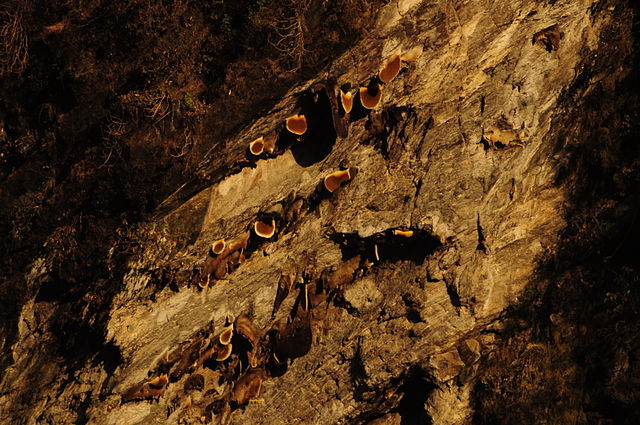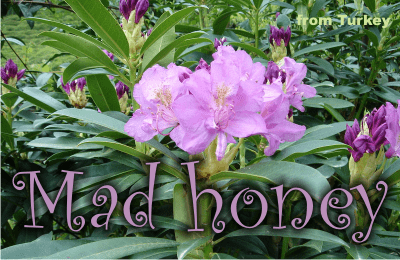For several years now, we have heard the words psychedelic honey and hallucinogenic honey. Obviously not our regular honey, but an exotic one coming from the high mountains of Nepal. It’s red, tasty, healthy, and a little toxic. Hence the hallucinogenic effects.
It’s a tough world! And searching for something, anything, that makes us happier is a normal thing. The reputation of some toxic honey, also called mad honey, red honey, hallucinogenic honey, as a product with psychoactive effects, has caught the attention of people. But as in many cases, reputation is oftentimes incomplete and misleading.
It can, indeed, be used with recreational purposes, but only specific honeys, in specific doses and in certain moments. There are few people who know all these things, and their explanations are incomplete. Not to mention that we have only a few scientific studies. (see footnotes)
We’ll see what’s true and what to expect.
Flowers can be toxic, poisonous. And just like with some people, :), poisonous flowers can be sweet and attractive to bees. The toxicity of these flowers do not harm the bees, so there is no problem for them.
How is red honey from Nepal?
Red Honey is produced by a specific honey bee.
In Nepal, there are at least 5 different honey bee species. The largest of them is The Giant Bee of Himalayas, Apis dorsata, a wild bee which reaches up to 3 cm, builds huge nests on the overhanging rocks of cliff faces, in the high forests of Himalaya.
These bees are commonly known as Khad mauri or Singkushe or cliff bee or King bees.
Apis dorsata is yellow in color with black strips on each abdominal segment. It builds a single comb, 1 to 1.6 m wide and 0.8 to 1.5 m long, underneath a stout branch of tall tree or building or water tower or cliff to protect their nests from top predators (according to FLETCHER in 1952; SEELEY et al. in 1982; CRANE in 1990; WONGSIRI et. al. in 1996).
The comb is protected by several layers of protective curtains. The protective curtains maintain a constant brood nest temperature between 30-33 °C.
 picture credit Sudan Shrestha, published under CC via Wikimedia Commons
picture credit Sudan Shrestha, published under CC via Wikimedia Commons
Their nests can reach up to 5 feet in diameter and each of them can contain about 60 kg of honey! (At least one knows it won’t get stung for nothing!)
Lots of beautiful flowers grow in those high forests, in rough conditions. The honey produced from their nectar is medicinal, aphrodisiac, intoxicating and hallucinogenic as well.
Red honey is made of mainly Rhododendron sp.
Red honey is a multifloral honey made of: Rhododendrons (Rhododendron anthopogon, R. cinnabarinum and R. panticum), Bikh (Aconitum spp.), Pangra (Entada scanders), Pieris (Pieris formosa) and Niramasi.
Other plants like: Ridhilo, Brassica compestris, Bassia butyracea, Fagopyrum sagittum, Eupatorium odoratum, Brassica nigra are all plants found in Nepal, offering their nectar to bees, so theoretically, bees can travel and add their nectar to the honey.
And, of course, red honey is expensive.
Due to its very hard ways of harvesting it, actually of stealing it from the bees, this mad honey is expensive and sells for about 4 times the price of normal honey in the foreign market. And we cannot have the guarantee of genuine red honey. The safest place to buy it is only from the locals. Go on a trip and buy some.
Red honey is not much consumed locally but exporters benefit from the export of this honey due to its medicinal value and relaxing properties. It is sold in a very high price to the Korean market.
It is harvested by honey hunters.

The people living in the area are called Gurungs, or honey hunters. There are over 3.5 Million Gurungs living in Nepal, and from them an isolated tribe with good knowledge of rock climbing, brave people called HONEY HUNTERS, are trained from generation to generation to collect the honey from the wild bees’ nests.
Hunting for this honey is a dangerous activity and most of the cliffs are named and remembered by the names of honey hunters who died during honey harvesting. The Gurungs must climb up treacherous cliffs and face the fury of swarming bees.
Their hunt takes place twice a year, in spring and autumn, and it begins at the break of dawn.
The villagers fill their knapsacks with essential supplies, and trek off to the foot of the nearest cliff.
With the help of only homemade hemp ropes and bamboo ladders, they begin their climb. The cliffs are often as tall as 300 meters.
The lead honey hunter collects the honey in a bucket from the beehives and passes down to another person. (See the video below.)
The total amount of honey produced in 26 nesting sites of Apis dorsata laboriosa is around 3053 Kg per year. Twelve villages are involved in this process.
It may take 2-3 hours or more to harvest one of the many colonies.
In the past, the hunters used to organize a religious ceremony before collecting honey to protect themselves from the attack of honeybees and any misshapen.
Today, the locals celebrate the hunting process as a festival by offering flowers, grains and sheep to God. It’s a sort of worship meant to show the respect of humans for the hard work of honeybees and their contribution to the survival of human beings.
Some traditional beliefs and superstitions of these hunters:
- Tuesday is the best day for initiating honey-hunting event, while Wednesday is not suitable for this event.
- Honey hunting is not allowed in 8th, 11th, 23rd, 26th and 30th day of moon cycle.
- Honey hunters believe that there are two gods in the forest i.e. local god, who looks after local events and the real god of cliff. Worshiping of these gods is mandatory by sacrificing, goat, sheep or chicken for giving blood in the name of god. Worship is also performed for those who passed away from the village.
- Either morning or evening time is considered good for honey hunting.
- In some places there is practice of pouring milk to the cliff before initiating honey hunting.
- Women are not even allowed to watch honey-hunting event in certain communities. They have to stay quite far from cliff site. It is believed that if they participate then the bees will be very aggressive.
- Main honey hunter gets the head of sacrificed animal while meat-cooked during the event is also tasted first by the honey hunter.
- One can not join honey-hunting team if his wife is menstruated or pregnant of over 6 months.
Is mad honey really hallucinogenic?
In small doses, honey can ensure a soothing sense of inebriation, much like the experience produced from a substance such as absinthe.
Some villagers ingest a teaspoon of the honey each morning, as they believe it strengthens the immune system and can lead to a longer and more fruitful life.
In larger quantities, it can induce cardiac arrest, full-scale hallucinations, or a period of time when the body seems to undergo a purge and rebirth. Who knows, maybe it actually does so.
“While trekking up in the high hills of Lamjung in Nepal, my friends and I took shelter at a tea-shop off the regular trekking route. There was a porter there with a fair amount of hash for sale and also a jar of what he called “pagal maha” or “mad honey”. None of my friends wanted it so I tried a spoonful. It was thick, not very sweet. I washed it down with some lemon tea and didn’t think much of it. That is, until we tried to goto sleep about an hour later and I realized I could hear my heartbeat in my ears. I felt hot and dizzy and couldn’t sleep at all. It was pitch black all around, but I could see points of light all around the roof of the tea shop. There was also this strange buzzing-roaring sound in my ears that sounded alternatively like bees and a large waterfall. Beyond that, there were no hallucinations, just extreme discomfort the entire night. Would not recommend mad honey. Not a pleasant experience at all.”
(reported by xkathmandu and published on upvoted.com)
It is said that the Honey Hunters can easily detect intoxicating honey by putting a drop of fresh honey on their skin and observing its color.
While rhododendrons grow in different parts of the world, only rhododendron honeys from Nepal and Turkey have hallucinogenic properties, as the density of rhododendrons are high enough to produce mad honey.
see Health benefits of Mad honey from Turkey (aka Deli Bal)
See for yourselves!
The filmmaker and world traveler Raphael Treza made a short documentary entitled Hallucinogen Honey Hunters. In the film, he meets with a Nepalese tribe to learn about this honey, and how they use it. During the making of the film, the translator ate too much of the honey and fell unconscious. For a while.
Can I see honey hunters in action? Maybe taste some mad red honey?
Yes. Here are 2 links to companies organizing these kinds of tours:
Above The Himalaya Trekking and Adventure Geo Treks.
Honey hunting is linked with a fast growing tourism industry in Nepal, which started attracting tourists intended to experience honey hunting in the high hills of the Himalayas.
It was reported that these honey-hunting groups pay US$ 250-1500 for experiencing one honey-hunting event. – this is to get an idea of the costs.
To see more pictures on gathering this type of honey see the website of Andrew Newey here: http://www.andrewnewey.com/. He is a professional passionate with Nepal and honey. See these pictures, you will surely be impressed and start planning a visit there! Hats off to Mr. Newey!
Is Himalayan Red Honey from Nepal toxic?
The name itself, mad honey, tells it all. It is toxic if the toxins are found in a significant amount.
From all the mad honeys known today, the most famous are Deli Bal from Turkey and Red Honey from Nepal. (click on the picture to learn more about Deli Bal.)
Find out why Himalayan red honey from Nepal is toxic and how to recognize the intoxication symptoms on the page Toxic Honey.
======================
References and picture sources:
· combs on Himalayan cliffs by Sudan Shrestha – Own work, CC BY-SA 3.0, https://commons.wikimedia.org/w/index.php?curid=32987417;
· combs with honey on a plate picture credit Skrissh2013 published under Creative Commons Attribution 3.0 Unported licence, via Wikimedia Commons;
· http://topdocumentaryfilms.com/hallucinogen-honey-hunters/
· EDGAR, J A; ROEDER, E L; MOLYNEUX, R J (2002) Honey from plants containing pyrrolizidine alkaloids:
A potential threat to health. Journal of agricultural and food chemistry 50 (10): 2719-2730.
· DE BODT, G (1996) Les miels de rhododendrons. Les Carnets du CARI Abeilles et Cie (50): 10-12.
· http://www.fda.gov/Food/FoodborneIllnessContaminants/CausesOfIllnessBadBugBook/ucm071128.htm
· http://nepalecotravel.com/?p=62
· http://www.icimod.org/v2/bull3/index.php/cms2/magic/view?q=1511



